HI6026 Audit, Assurance: Auditor's Public Interest & Enron Lessons
VerifiedAdded on 2023/05/28
|16
|4138
|454
Report
AI Summary
This report provides a detailed analysis of auditing principles, focusing on stakeholder analysis with the Commonwealth Bank of Australia as a case study. It explores the critical role of auditor independence, whistleblowing, and compliance with APES 110, emphasizing the importance of public interest requirements. Furthermore, the report examines the lessons learned from the Enron scandal, highlighting the need for increased auditor independence, prudent judgment, and robust systems for identifying irregularities. The analysis underscores the significance of audit quality and the responsibilities of auditors in ensuring the reliability of financial statements and maintaining investor trust.
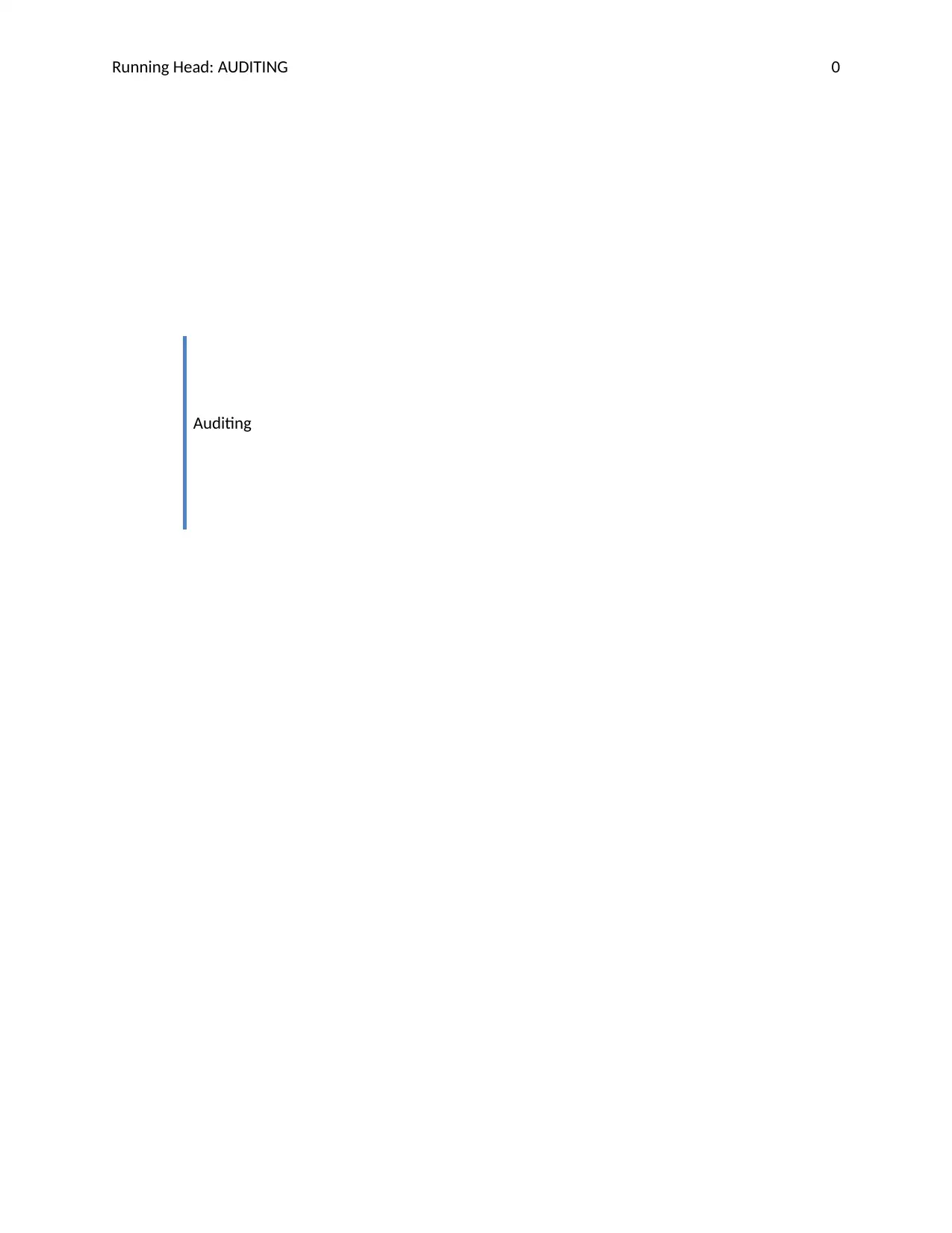
Running Head: AUDITING 0
Auditing
Auditing
Paraphrase This Document
Need a fresh take? Get an instant paraphrase of this document with our AI Paraphraser
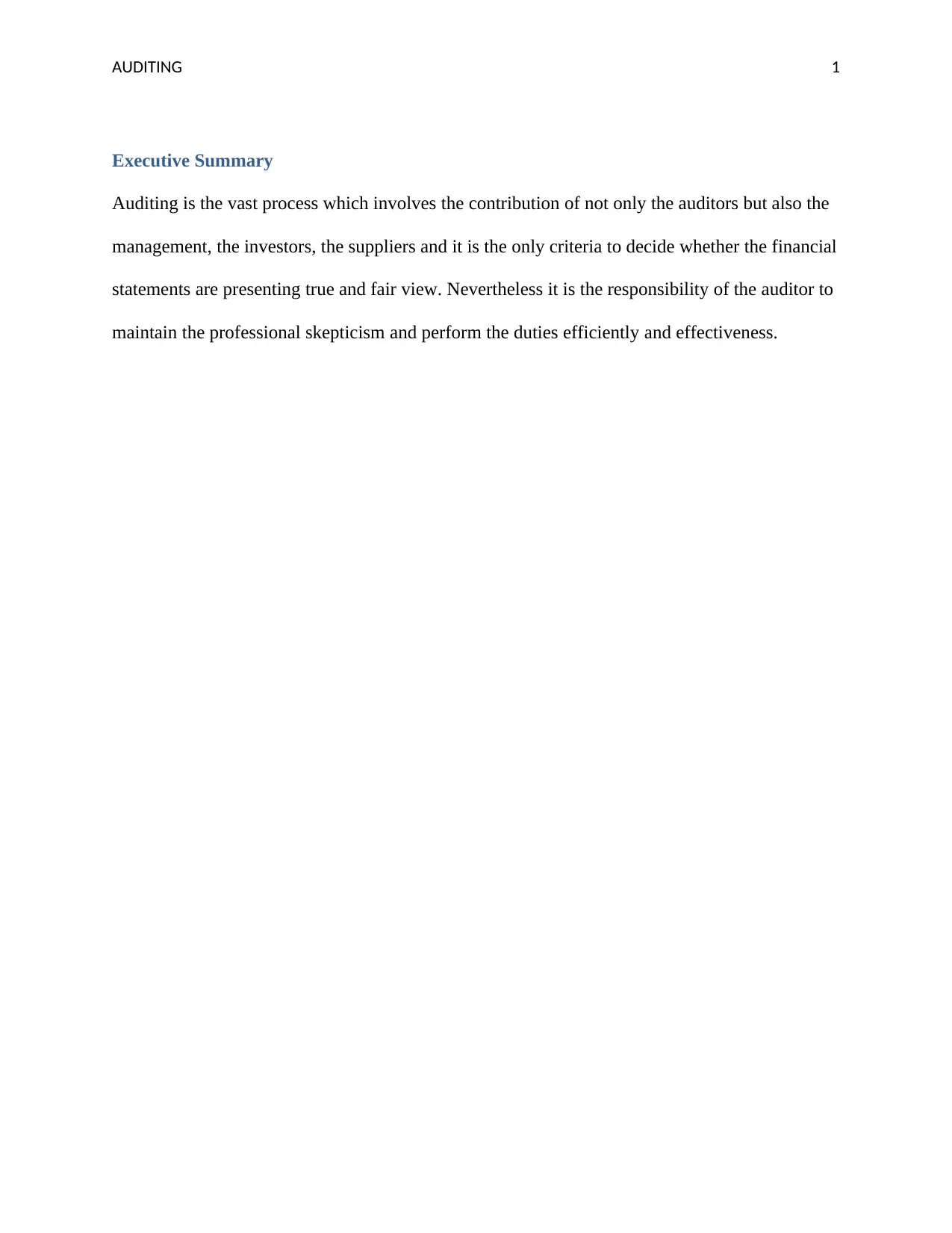
AUDITING 1
Executive Summary
Auditing is the vast process which involves the contribution of not only the auditors but also the
management, the investors, the suppliers and it is the only criteria to decide whether the financial
statements are presenting true and fair view. Nevertheless it is the responsibility of the auditor to
maintain the professional skepticism and perform the duties efficiently and effectiveness.
Executive Summary
Auditing is the vast process which involves the contribution of not only the auditors but also the
management, the investors, the suppliers and it is the only criteria to decide whether the financial
statements are presenting true and fair view. Nevertheless it is the responsibility of the auditor to
maintain the professional skepticism and perform the duties efficiently and effectiveness.
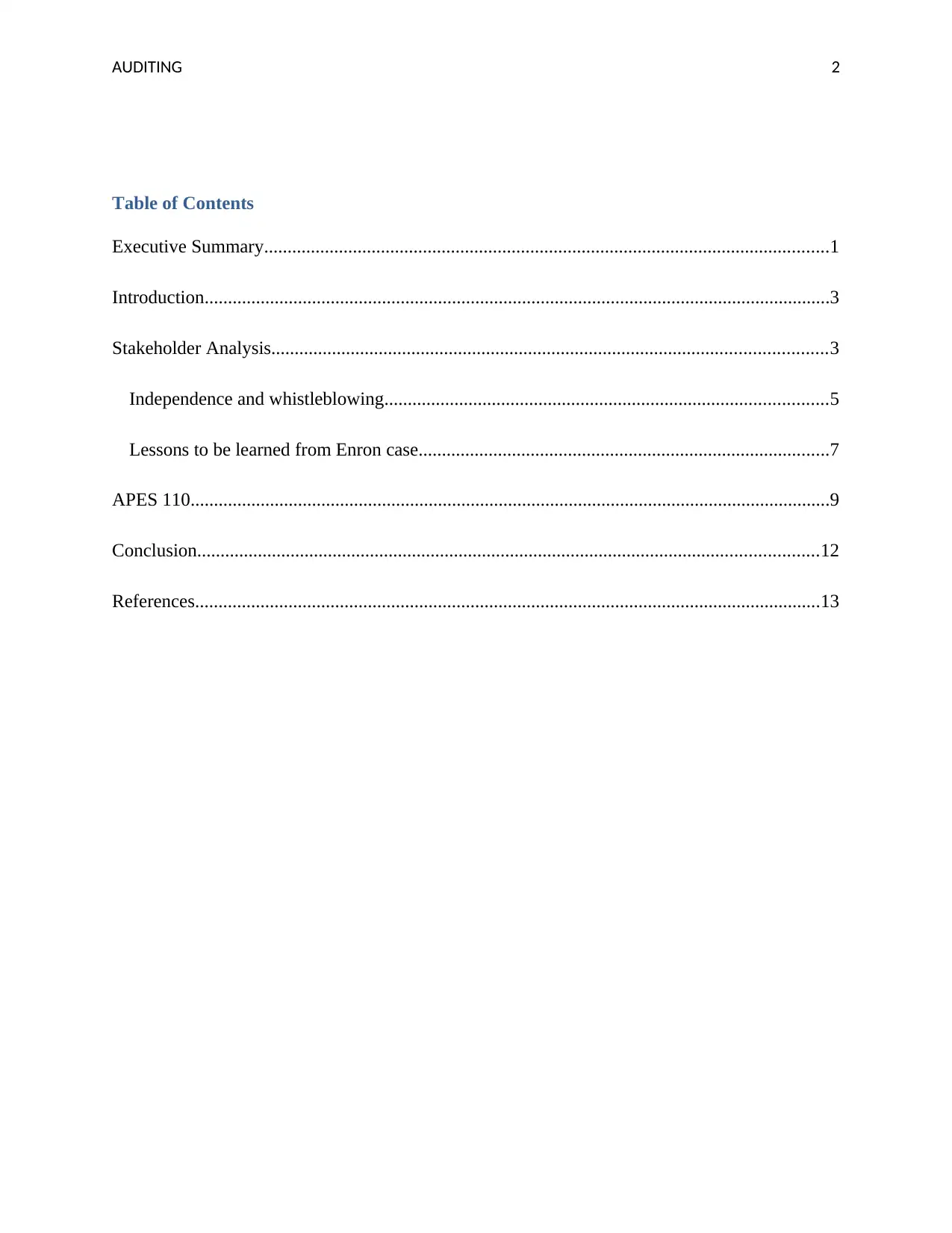
AUDITING 2
Table of Contents
Executive Summary.........................................................................................................................1
Introduction......................................................................................................................................3
Stakeholder Analysis.......................................................................................................................3
Independence and whistleblowing...............................................................................................5
Lessons to be learned from Enron case........................................................................................7
APES 110.........................................................................................................................................9
Conclusion.....................................................................................................................................12
References......................................................................................................................................13
Table of Contents
Executive Summary.........................................................................................................................1
Introduction......................................................................................................................................3
Stakeholder Analysis.......................................................................................................................3
Independence and whistleblowing...............................................................................................5
Lessons to be learned from Enron case........................................................................................7
APES 110.........................................................................................................................................9
Conclusion.....................................................................................................................................12
References......................................................................................................................................13
⊘ This is a preview!⊘
Do you want full access?
Subscribe today to unlock all pages.

Trusted by 1+ million students worldwide
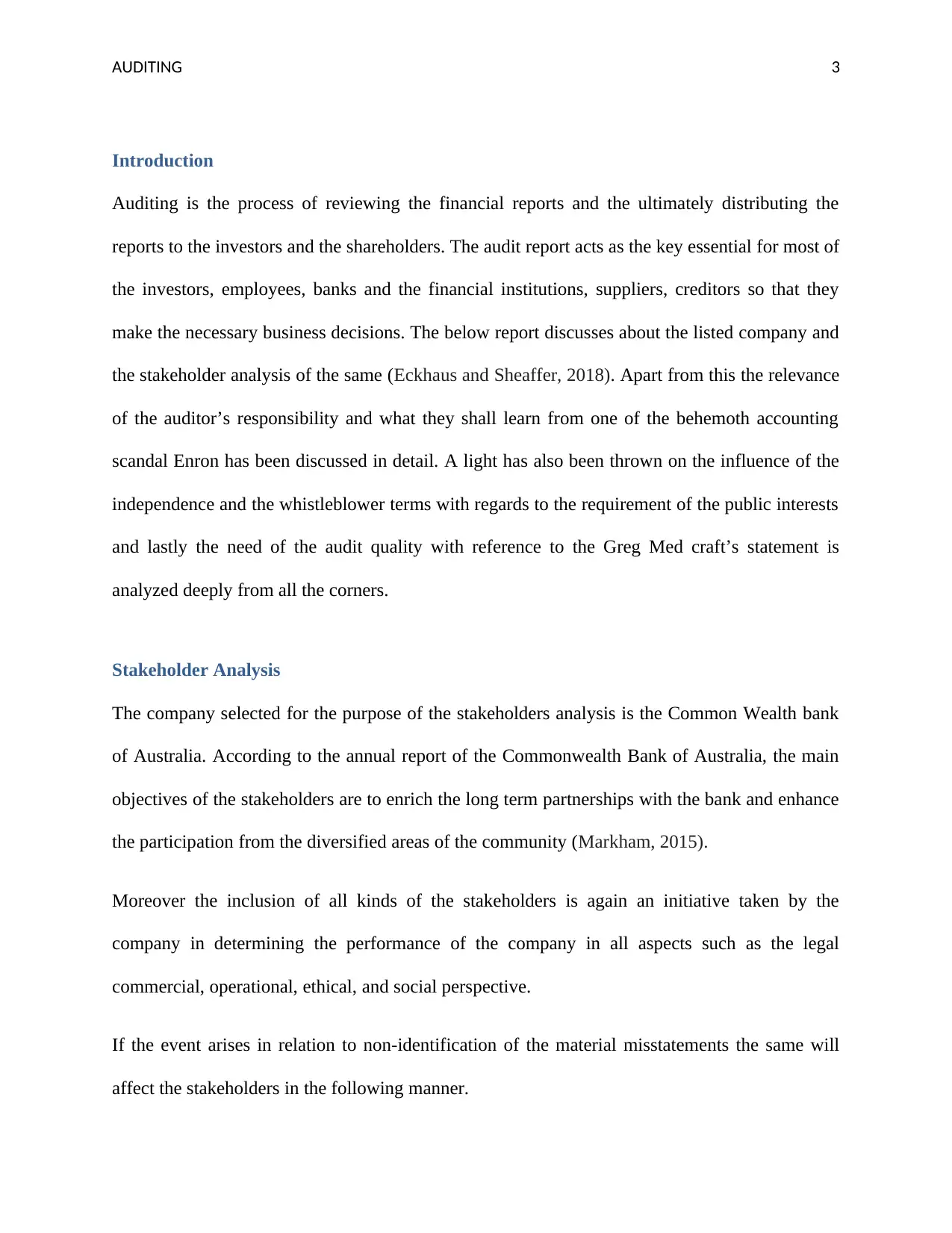
AUDITING 3
Introduction
Auditing is the process of reviewing the financial reports and the ultimately distributing the
reports to the investors and the shareholders. The audit report acts as the key essential for most of
the investors, employees, banks and the financial institutions, suppliers, creditors so that they
make the necessary business decisions. The below report discusses about the listed company and
the stakeholder analysis of the same (Eckhaus and Sheaffer, 2018). Apart from this the relevance
of the auditor’s responsibility and what they shall learn from one of the behemoth accounting
scandal Enron has been discussed in detail. A light has also been thrown on the influence of the
independence and the whistleblower terms with regards to the requirement of the public interests
and lastly the need of the audit quality with reference to the Greg Med craft’s statement is
analyzed deeply from all the corners.
Stakeholder Analysis
The company selected for the purpose of the stakeholders analysis is the Common Wealth bank
of Australia. According to the annual report of the Commonwealth Bank of Australia, the main
objectives of the stakeholders are to enrich the long term partnerships with the bank and enhance
the participation from the diversified areas of the community (Markham, 2015).
Moreover the inclusion of all kinds of the stakeholders is again an initiative taken by the
company in determining the performance of the company in all aspects such as the legal
commercial, operational, ethical, and social perspective.
If the event arises in relation to non-identification of the material misstatements the same will
affect the stakeholders in the following manner.
Introduction
Auditing is the process of reviewing the financial reports and the ultimately distributing the
reports to the investors and the shareholders. The audit report acts as the key essential for most of
the investors, employees, banks and the financial institutions, suppliers, creditors so that they
make the necessary business decisions. The below report discusses about the listed company and
the stakeholder analysis of the same (Eckhaus and Sheaffer, 2018). Apart from this the relevance
of the auditor’s responsibility and what they shall learn from one of the behemoth accounting
scandal Enron has been discussed in detail. A light has also been thrown on the influence of the
independence and the whistleblower terms with regards to the requirement of the public interests
and lastly the need of the audit quality with reference to the Greg Med craft’s statement is
analyzed deeply from all the corners.
Stakeholder Analysis
The company selected for the purpose of the stakeholders analysis is the Common Wealth bank
of Australia. According to the annual report of the Commonwealth Bank of Australia, the main
objectives of the stakeholders are to enrich the long term partnerships with the bank and enhance
the participation from the diversified areas of the community (Markham, 2015).
Moreover the inclusion of all kinds of the stakeholders is again an initiative taken by the
company in determining the performance of the company in all aspects such as the legal
commercial, operational, ethical, and social perspective.
If the event arises in relation to non-identification of the material misstatements the same will
affect the stakeholders in the following manner.
Paraphrase This Document
Need a fresh take? Get an instant paraphrase of this document with our AI Paraphraser
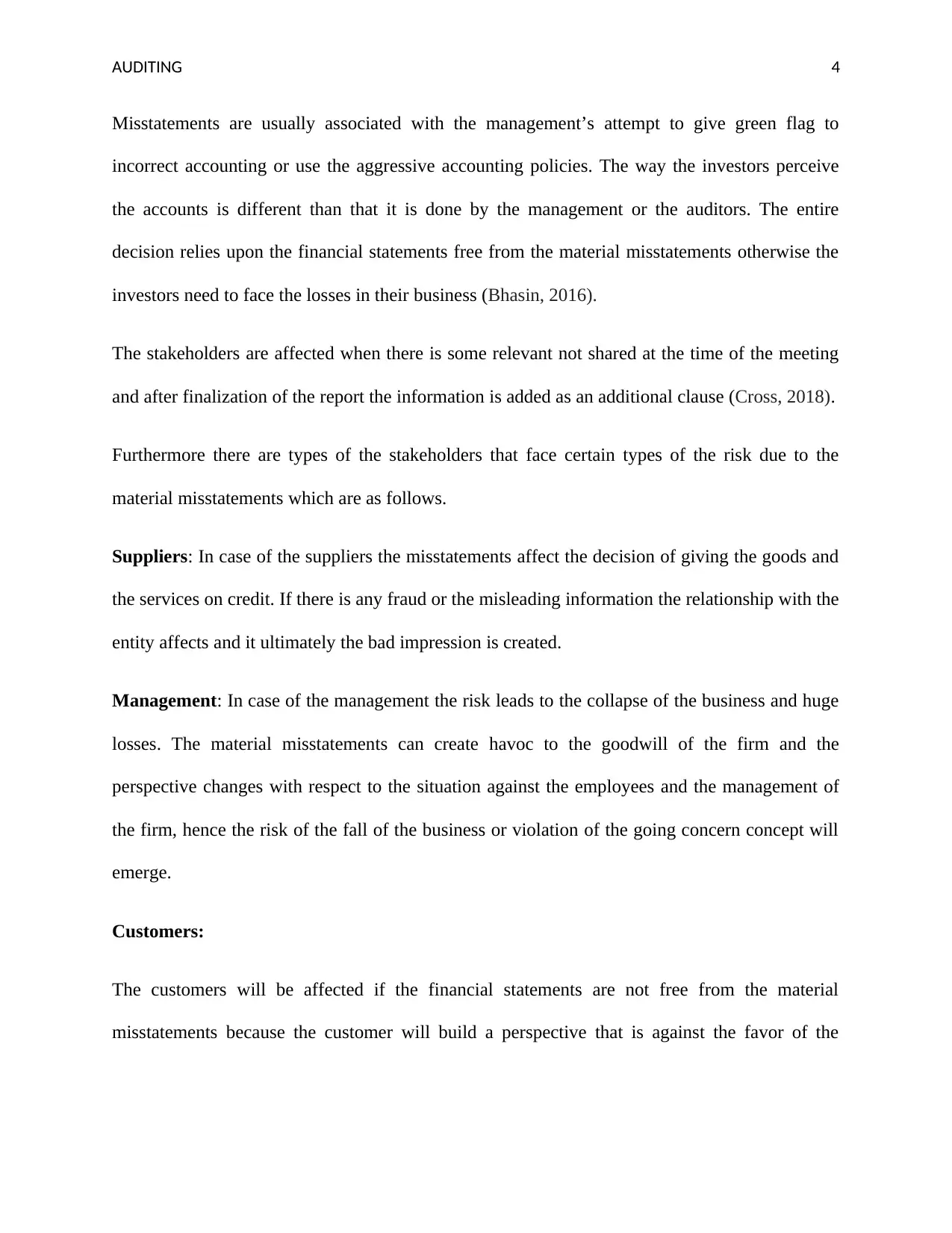
AUDITING 4
Misstatements are usually associated with the management’s attempt to give green flag to
incorrect accounting or use the aggressive accounting policies. The way the investors perceive
the accounts is different than that it is done by the management or the auditors. The entire
decision relies upon the financial statements free from the material misstatements otherwise the
investors need to face the losses in their business (Bhasin, 2016).
The stakeholders are affected when there is some relevant not shared at the time of the meeting
and after finalization of the report the information is added as an additional clause (Cross, 2018).
Furthermore there are types of the stakeholders that face certain types of the risk due to the
material misstatements which are as follows.
Suppliers: In case of the suppliers the misstatements affect the decision of giving the goods and
the services on credit. If there is any fraud or the misleading information the relationship with the
entity affects and it ultimately the bad impression is created.
Management: In case of the management the risk leads to the collapse of the business and huge
losses. The material misstatements can create havoc to the goodwill of the firm and the
perspective changes with respect to the situation against the employees and the management of
the firm, hence the risk of the fall of the business or violation of the going concern concept will
emerge.
Customers:
The customers will be affected if the financial statements are not free from the material
misstatements because the customer will build a perspective that is against the favor of the
Misstatements are usually associated with the management’s attempt to give green flag to
incorrect accounting or use the aggressive accounting policies. The way the investors perceive
the accounts is different than that it is done by the management or the auditors. The entire
decision relies upon the financial statements free from the material misstatements otherwise the
investors need to face the losses in their business (Bhasin, 2016).
The stakeholders are affected when there is some relevant not shared at the time of the meeting
and after finalization of the report the information is added as an additional clause (Cross, 2018).
Furthermore there are types of the stakeholders that face certain types of the risk due to the
material misstatements which are as follows.
Suppliers: In case of the suppliers the misstatements affect the decision of giving the goods and
the services on credit. If there is any fraud or the misleading information the relationship with the
entity affects and it ultimately the bad impression is created.
Management: In case of the management the risk leads to the collapse of the business and huge
losses. The material misstatements can create havoc to the goodwill of the firm and the
perspective changes with respect to the situation against the employees and the management of
the firm, hence the risk of the fall of the business or violation of the going concern concept will
emerge.
Customers:
The customers will be affected if the financial statements are not free from the material
misstatements because the customer will build a perspective that is against the favor of the
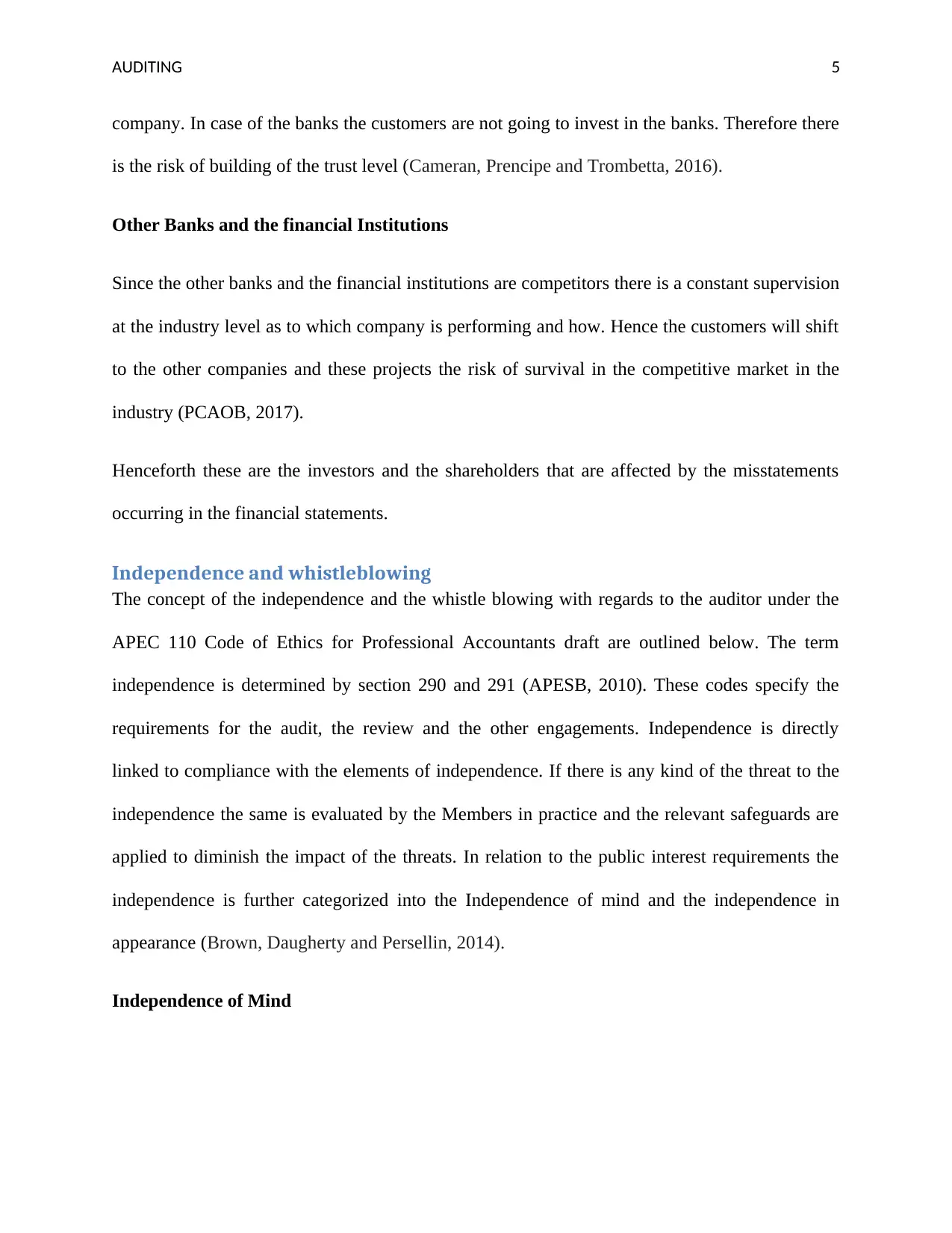
AUDITING 5
company. In case of the banks the customers are not going to invest in the banks. Therefore there
is the risk of building of the trust level (Cameran, Prencipe and Trombetta, 2016).
Other Banks and the financial Institutions
Since the other banks and the financial institutions are competitors there is a constant supervision
at the industry level as to which company is performing and how. Hence the customers will shift
to the other companies and these projects the risk of survival in the competitive market in the
industry (PCAOB, 2017).
Henceforth these are the investors and the shareholders that are affected by the misstatements
occurring in the financial statements.
Independence and whistleblowing
The concept of the independence and the whistle blowing with regards to the auditor under the
APEC 110 Code of Ethics for Professional Accountants draft are outlined below. The term
independence is determined by section 290 and 291 (APESB, 2010). These codes specify the
requirements for the audit, the review and the other engagements. Independence is directly
linked to compliance with the elements of independence. If there is any kind of the threat to the
independence the same is evaluated by the Members in practice and the relevant safeguards are
applied to diminish the impact of the threats. In relation to the public interest requirements the
independence is further categorized into the Independence of mind and the independence in
appearance (Brown, Daugherty and Persellin, 2014).
Independence of Mind
company. In case of the banks the customers are not going to invest in the banks. Therefore there
is the risk of building of the trust level (Cameran, Prencipe and Trombetta, 2016).
Other Banks and the financial Institutions
Since the other banks and the financial institutions are competitors there is a constant supervision
at the industry level as to which company is performing and how. Hence the customers will shift
to the other companies and these projects the risk of survival in the competitive market in the
industry (PCAOB, 2017).
Henceforth these are the investors and the shareholders that are affected by the misstatements
occurring in the financial statements.
Independence and whistleblowing
The concept of the independence and the whistle blowing with regards to the auditor under the
APEC 110 Code of Ethics for Professional Accountants draft are outlined below. The term
independence is determined by section 290 and 291 (APESB, 2010). These codes specify the
requirements for the audit, the review and the other engagements. Independence is directly
linked to compliance with the elements of independence. If there is any kind of the threat to the
independence the same is evaluated by the Members in practice and the relevant safeguards are
applied to diminish the impact of the threats. In relation to the public interest requirements the
independence is further categorized into the Independence of mind and the independence in
appearance (Brown, Daugherty and Persellin, 2014).
Independence of Mind
⊘ This is a preview!⊘
Do you want full access?
Subscribe today to unlock all pages.

Trusted by 1+ million students worldwide
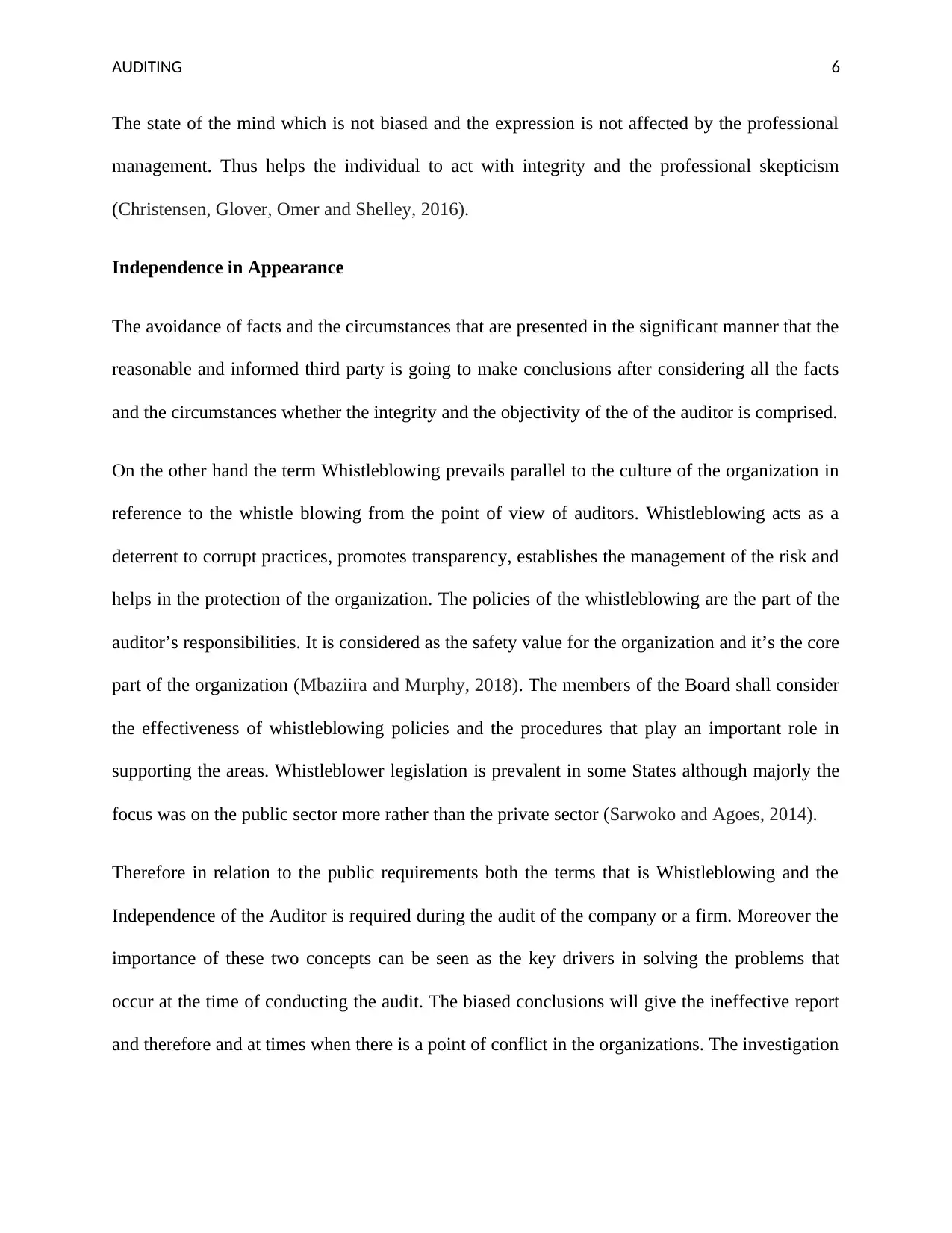
AUDITING 6
The state of the mind which is not biased and the expression is not affected by the professional
management. Thus helps the individual to act with integrity and the professional skepticism
(Christensen, Glover, Omer and Shelley, 2016).
Independence in Appearance
The avoidance of facts and the circumstances that are presented in the significant manner that the
reasonable and informed third party is going to make conclusions after considering all the facts
and the circumstances whether the integrity and the objectivity of the of the auditor is comprised.
On the other hand the term Whistleblowing prevails parallel to the culture of the organization in
reference to the whistle blowing from the point of view of auditors. Whistleblowing acts as a
deterrent to corrupt practices, promotes transparency, establishes the management of the risk and
helps in the protection of the organization. The policies of the whistleblowing are the part of the
auditor’s responsibilities. It is considered as the safety value for the organization and it’s the core
part of the organization (Mbaziira and Murphy, 2018). The members of the Board shall consider
the effectiveness of whistleblowing policies and the procedures that play an important role in
supporting the areas. Whistleblower legislation is prevalent in some States although majorly the
focus was on the public sector more rather than the private sector (Sarwoko and Agoes, 2014).
Therefore in relation to the public requirements both the terms that is Whistleblowing and the
Independence of the Auditor is required during the audit of the company or a firm. Moreover the
importance of these two concepts can be seen as the key drivers in solving the problems that
occur at the time of conducting the audit. The biased conclusions will give the ineffective report
and therefore and at times when there is a point of conflict in the organizations. The investigation
The state of the mind which is not biased and the expression is not affected by the professional
management. Thus helps the individual to act with integrity and the professional skepticism
(Christensen, Glover, Omer and Shelley, 2016).
Independence in Appearance
The avoidance of facts and the circumstances that are presented in the significant manner that the
reasonable and informed third party is going to make conclusions after considering all the facts
and the circumstances whether the integrity and the objectivity of the of the auditor is comprised.
On the other hand the term Whistleblowing prevails parallel to the culture of the organization in
reference to the whistle blowing from the point of view of auditors. Whistleblowing acts as a
deterrent to corrupt practices, promotes transparency, establishes the management of the risk and
helps in the protection of the organization. The policies of the whistleblowing are the part of the
auditor’s responsibilities. It is considered as the safety value for the organization and it’s the core
part of the organization (Mbaziira and Murphy, 2018). The members of the Board shall consider
the effectiveness of whistleblowing policies and the procedures that play an important role in
supporting the areas. Whistleblower legislation is prevalent in some States although majorly the
focus was on the public sector more rather than the private sector (Sarwoko and Agoes, 2014).
Therefore in relation to the public requirements both the terms that is Whistleblowing and the
Independence of the Auditor is required during the audit of the company or a firm. Moreover the
importance of these two concepts can be seen as the key drivers in solving the problems that
occur at the time of conducting the audit. The biased conclusions will give the ineffective report
and therefore and at times when there is a point of conflict in the organizations. The investigation
Paraphrase This Document
Need a fresh take? Get an instant paraphrase of this document with our AI Paraphraser
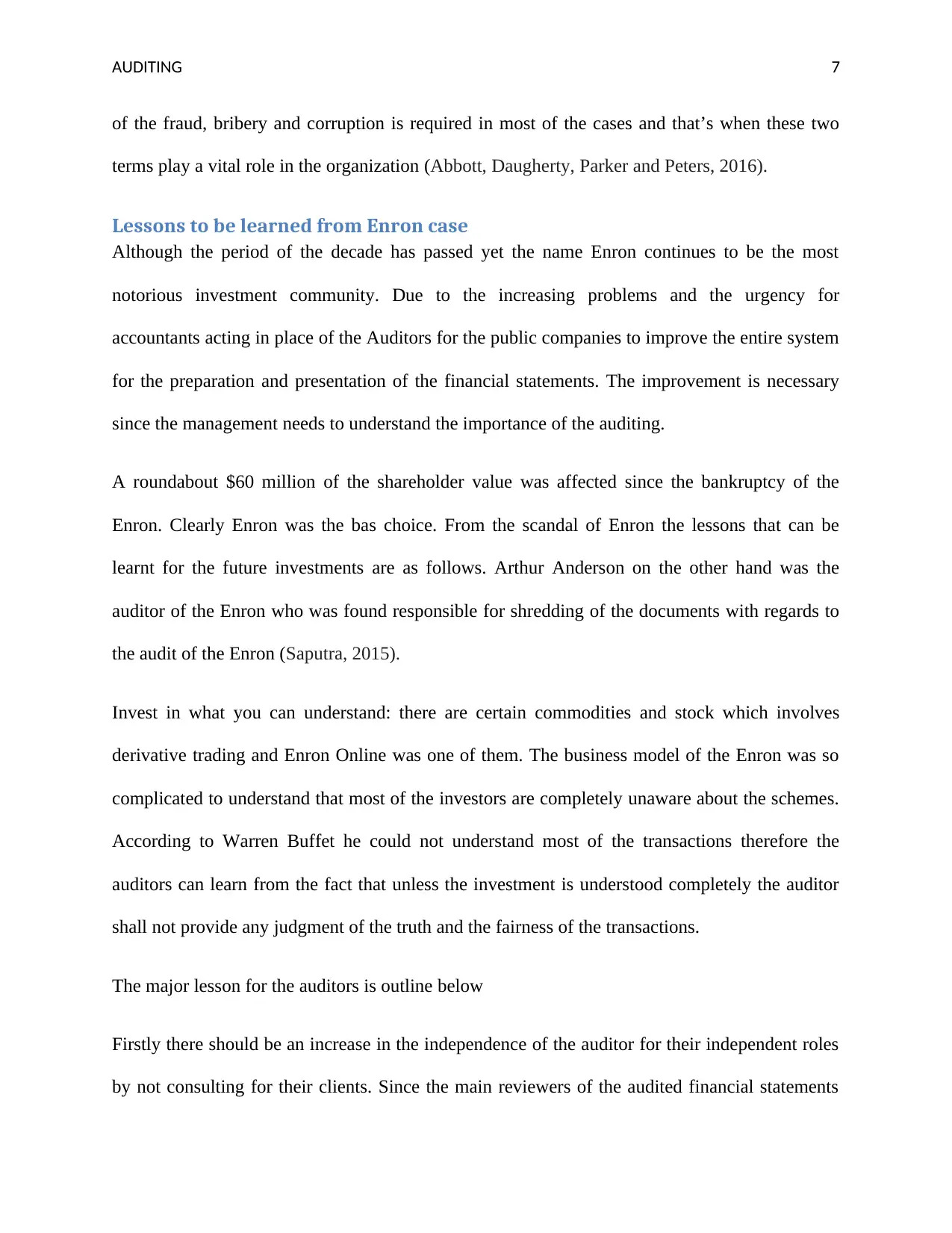
AUDITING 7
of the fraud, bribery and corruption is required in most of the cases and that’s when these two
terms play a vital role in the organization (Abbott, Daugherty, Parker and Peters, 2016).
Lessons to be learned from Enron case
Although the period of the decade has passed yet the name Enron continues to be the most
notorious investment community. Due to the increasing problems and the urgency for
accountants acting in place of the Auditors for the public companies to improve the entire system
for the preparation and presentation of the financial statements. The improvement is necessary
since the management needs to understand the importance of the auditing.
A roundabout $60 million of the shareholder value was affected since the bankruptcy of the
Enron. Clearly Enron was the bas choice. From the scandal of Enron the lessons that can be
learnt for the future investments are as follows. Arthur Anderson on the other hand was the
auditor of the Enron who was found responsible for shredding of the documents with regards to
the audit of the Enron (Saputra, 2015).
Invest in what you can understand: there are certain commodities and stock which involves
derivative trading and Enron Online was one of them. The business model of the Enron was so
complicated to understand that most of the investors are completely unaware about the schemes.
According to Warren Buffet he could not understand most of the transactions therefore the
auditors can learn from the fact that unless the investment is understood completely the auditor
shall not provide any judgment of the truth and the fairness of the transactions.
The major lesson for the auditors is outline below
Firstly there should be an increase in the independence of the auditor for their independent roles
by not consulting for their clients. Since the main reviewers of the audited financial statements
of the fraud, bribery and corruption is required in most of the cases and that’s when these two
terms play a vital role in the organization (Abbott, Daugherty, Parker and Peters, 2016).
Lessons to be learned from Enron case
Although the period of the decade has passed yet the name Enron continues to be the most
notorious investment community. Due to the increasing problems and the urgency for
accountants acting in place of the Auditors for the public companies to improve the entire system
for the preparation and presentation of the financial statements. The improvement is necessary
since the management needs to understand the importance of the auditing.
A roundabout $60 million of the shareholder value was affected since the bankruptcy of the
Enron. Clearly Enron was the bas choice. From the scandal of Enron the lessons that can be
learnt for the future investments are as follows. Arthur Anderson on the other hand was the
auditor of the Enron who was found responsible for shredding of the documents with regards to
the audit of the Enron (Saputra, 2015).
Invest in what you can understand: there are certain commodities and stock which involves
derivative trading and Enron Online was one of them. The business model of the Enron was so
complicated to understand that most of the investors are completely unaware about the schemes.
According to Warren Buffet he could not understand most of the transactions therefore the
auditors can learn from the fact that unless the investment is understood completely the auditor
shall not provide any judgment of the truth and the fairness of the transactions.
The major lesson for the auditors is outline below
Firstly there should be an increase in the independence of the auditor for their independent roles
by not consulting for their clients. Since the main reviewers of the audited financial statements
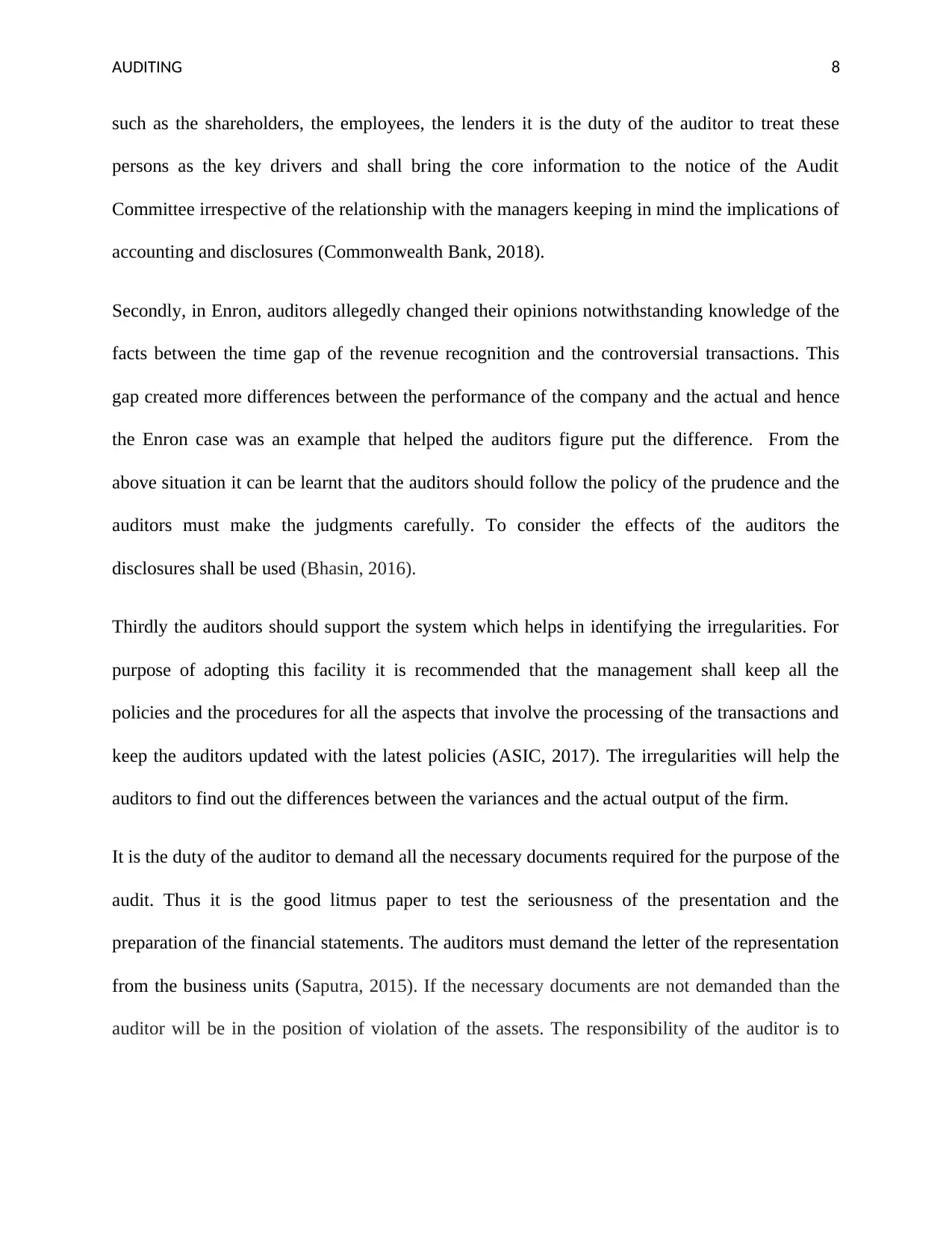
AUDITING 8
such as the shareholders, the employees, the lenders it is the duty of the auditor to treat these
persons as the key drivers and shall bring the core information to the notice of the Audit
Committee irrespective of the relationship with the managers keeping in mind the implications of
accounting and disclosures (Commonwealth Bank, 2018).
Secondly, in Enron, auditors allegedly changed their opinions notwithstanding knowledge of the
facts between the time gap of the revenue recognition and the controversial transactions. This
gap created more differences between the performance of the company and the actual and hence
the Enron case was an example that helped the auditors figure put the difference. From the
above situation it can be learnt that the auditors should follow the policy of the prudence and the
auditors must make the judgments carefully. To consider the effects of the auditors the
disclosures shall be used (Bhasin, 2016).
Thirdly the auditors should support the system which helps in identifying the irregularities. For
purpose of adopting this facility it is recommended that the management shall keep all the
policies and the procedures for all the aspects that involve the processing of the transactions and
keep the auditors updated with the latest policies (ASIC, 2017). The irregularities will help the
auditors to find out the differences between the variances and the actual output of the firm.
It is the duty of the auditor to demand all the necessary documents required for the purpose of the
audit. Thus it is the good litmus paper to test the seriousness of the presentation and the
preparation of the financial statements. The auditors must demand the letter of the representation
from the business units (Saputra, 2015). If the necessary documents are not demanded than the
auditor will be in the position of violation of the assets. The responsibility of the auditor is to
such as the shareholders, the employees, the lenders it is the duty of the auditor to treat these
persons as the key drivers and shall bring the core information to the notice of the Audit
Committee irrespective of the relationship with the managers keeping in mind the implications of
accounting and disclosures (Commonwealth Bank, 2018).
Secondly, in Enron, auditors allegedly changed their opinions notwithstanding knowledge of the
facts between the time gap of the revenue recognition and the controversial transactions. This
gap created more differences between the performance of the company and the actual and hence
the Enron case was an example that helped the auditors figure put the difference. From the
above situation it can be learnt that the auditors should follow the policy of the prudence and the
auditors must make the judgments carefully. To consider the effects of the auditors the
disclosures shall be used (Bhasin, 2016).
Thirdly the auditors should support the system which helps in identifying the irregularities. For
purpose of adopting this facility it is recommended that the management shall keep all the
policies and the procedures for all the aspects that involve the processing of the transactions and
keep the auditors updated with the latest policies (ASIC, 2017). The irregularities will help the
auditors to find out the differences between the variances and the actual output of the firm.
It is the duty of the auditor to demand all the necessary documents required for the purpose of the
audit. Thus it is the good litmus paper to test the seriousness of the presentation and the
preparation of the financial statements. The auditors must demand the letter of the representation
from the business units (Saputra, 2015). If the necessary documents are not demanded than the
auditor will be in the position of violation of the assets. The responsibility of the auditor is to
⊘ This is a preview!⊘
Do you want full access?
Subscribe today to unlock all pages.

Trusted by 1+ million students worldwide
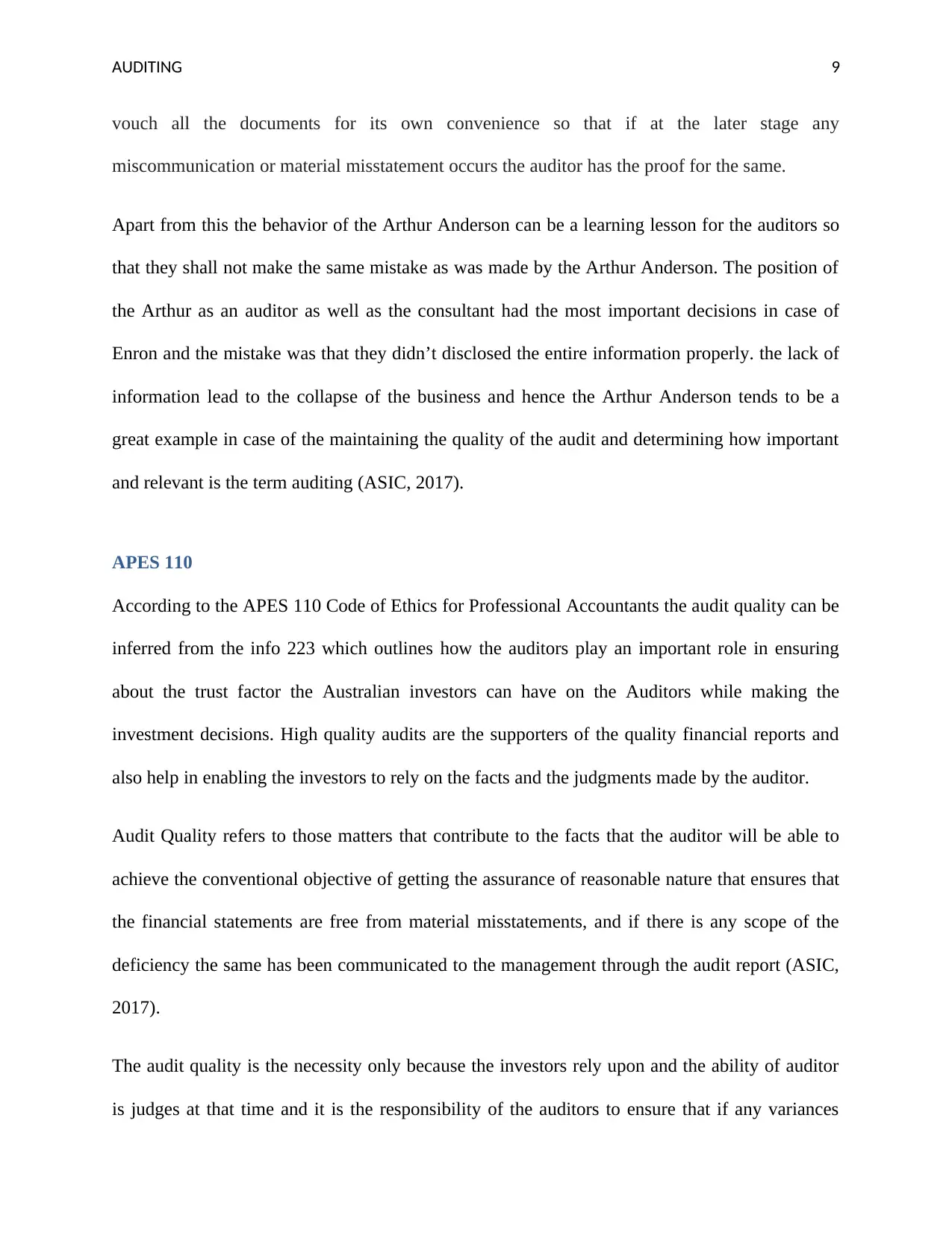
AUDITING 9
vouch all the documents for its own convenience so that if at the later stage any
miscommunication or material misstatement occurs the auditor has the proof for the same.
Apart from this the behavior of the Arthur Anderson can be a learning lesson for the auditors so
that they shall not make the same mistake as was made by the Arthur Anderson. The position of
the Arthur as an auditor as well as the consultant had the most important decisions in case of
Enron and the mistake was that they didn’t disclosed the entire information properly. the lack of
information lead to the collapse of the business and hence the Arthur Anderson tends to be a
great example in case of the maintaining the quality of the audit and determining how important
and relevant is the term auditing (ASIC, 2017).
APES 110
According to the APES 110 Code of Ethics for Professional Accountants the audit quality can be
inferred from the info 223 which outlines how the auditors play an important role in ensuring
about the trust factor the Australian investors can have on the Auditors while making the
investment decisions. High quality audits are the supporters of the quality financial reports and
also help in enabling the investors to rely on the facts and the judgments made by the auditor.
Audit Quality refers to those matters that contribute to the facts that the auditor will be able to
achieve the conventional objective of getting the assurance of reasonable nature that ensures that
the financial statements are free from material misstatements, and if there is any scope of the
deficiency the same has been communicated to the management through the audit report (ASIC,
2017).
The audit quality is the necessity only because the investors rely upon and the ability of auditor
is judges at that time and it is the responsibility of the auditors to ensure that if any variances
vouch all the documents for its own convenience so that if at the later stage any
miscommunication or material misstatement occurs the auditor has the proof for the same.
Apart from this the behavior of the Arthur Anderson can be a learning lesson for the auditors so
that they shall not make the same mistake as was made by the Arthur Anderson. The position of
the Arthur as an auditor as well as the consultant had the most important decisions in case of
Enron and the mistake was that they didn’t disclosed the entire information properly. the lack of
information lead to the collapse of the business and hence the Arthur Anderson tends to be a
great example in case of the maintaining the quality of the audit and determining how important
and relevant is the term auditing (ASIC, 2017).
APES 110
According to the APES 110 Code of Ethics for Professional Accountants the audit quality can be
inferred from the info 223 which outlines how the auditors play an important role in ensuring
about the trust factor the Australian investors can have on the Auditors while making the
investment decisions. High quality audits are the supporters of the quality financial reports and
also help in enabling the investors to rely on the facts and the judgments made by the auditor.
Audit Quality refers to those matters that contribute to the facts that the auditor will be able to
achieve the conventional objective of getting the assurance of reasonable nature that ensures that
the financial statements are free from material misstatements, and if there is any scope of the
deficiency the same has been communicated to the management through the audit report (ASIC,
2017).
The audit quality is the necessity only because the investors rely upon and the ability of auditor
is judges at that time and it is the responsibility of the auditors to ensure that if any variances
Paraphrase This Document
Need a fresh take? Get an instant paraphrase of this document with our AI Paraphraser
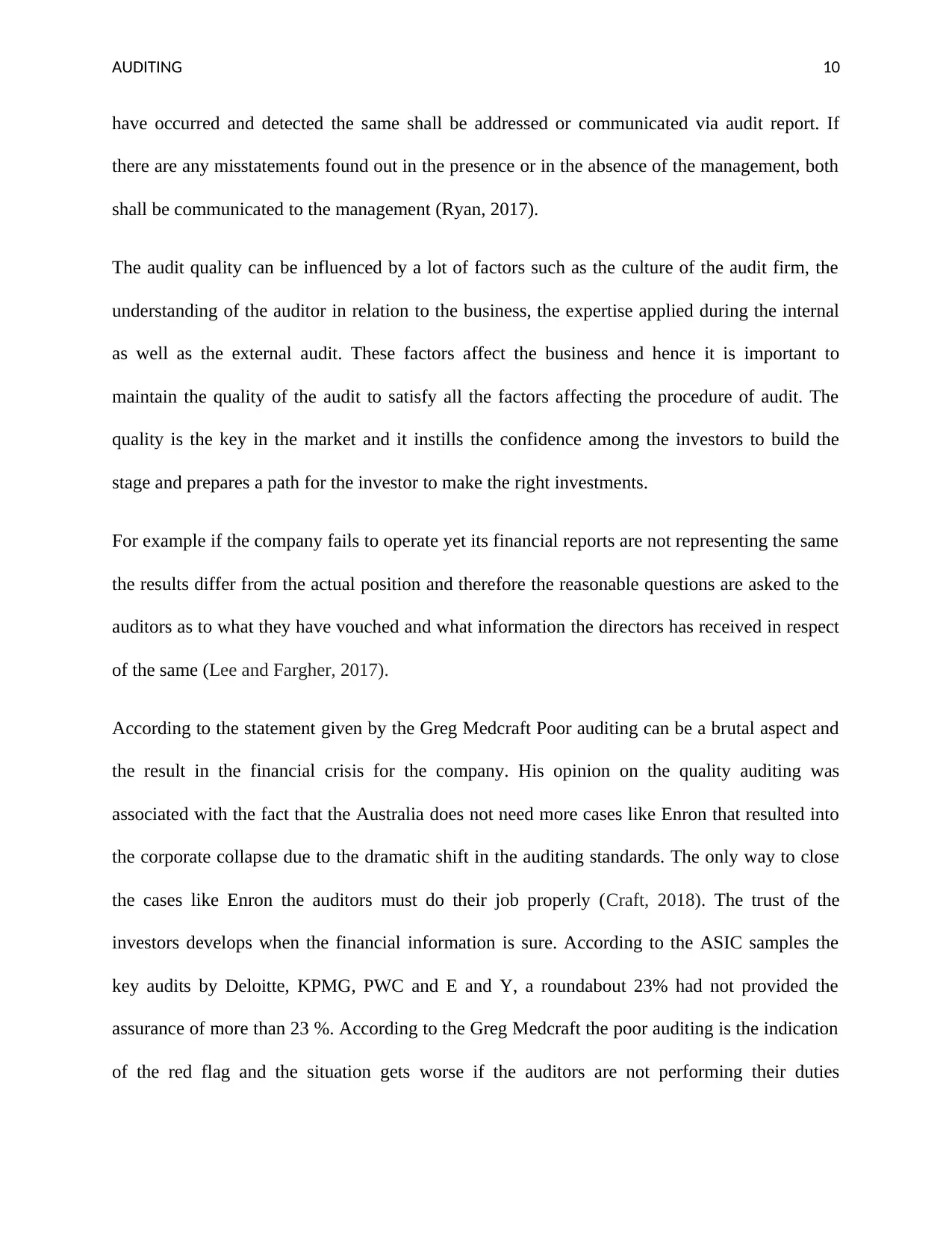
AUDITING 10
have occurred and detected the same shall be addressed or communicated via audit report. If
there are any misstatements found out in the presence or in the absence of the management, both
shall be communicated to the management (Ryan, 2017).
The audit quality can be influenced by a lot of factors such as the culture of the audit firm, the
understanding of the auditor in relation to the business, the expertise applied during the internal
as well as the external audit. These factors affect the business and hence it is important to
maintain the quality of the audit to satisfy all the factors affecting the procedure of audit. The
quality is the key in the market and it instills the confidence among the investors to build the
stage and prepares a path for the investor to make the right investments.
For example if the company fails to operate yet its financial reports are not representing the same
the results differ from the actual position and therefore the reasonable questions are asked to the
auditors as to what they have vouched and what information the directors has received in respect
of the same (Lee and Fargher, 2017).
According to the statement given by the Greg Medcraft Poor auditing can be a brutal aspect and
the result in the financial crisis for the company. His opinion on the quality auditing was
associated with the fact that the Australia does not need more cases like Enron that resulted into
the corporate collapse due to the dramatic shift in the auditing standards. The only way to close
the cases like Enron the auditors must do their job properly (Craft, 2018). The trust of the
investors develops when the financial information is sure. According to the ASIC samples the
key audits by Deloitte, KPMG, PWC and E and Y, a roundabout 23% had not provided the
assurance of more than 23 %. According to the Greg Medcraft the poor auditing is the indication
of the red flag and the situation gets worse if the auditors are not performing their duties
have occurred and detected the same shall be addressed or communicated via audit report. If
there are any misstatements found out in the presence or in the absence of the management, both
shall be communicated to the management (Ryan, 2017).
The audit quality can be influenced by a lot of factors such as the culture of the audit firm, the
understanding of the auditor in relation to the business, the expertise applied during the internal
as well as the external audit. These factors affect the business and hence it is important to
maintain the quality of the audit to satisfy all the factors affecting the procedure of audit. The
quality is the key in the market and it instills the confidence among the investors to build the
stage and prepares a path for the investor to make the right investments.
For example if the company fails to operate yet its financial reports are not representing the same
the results differ from the actual position and therefore the reasonable questions are asked to the
auditors as to what they have vouched and what information the directors has received in respect
of the same (Lee and Fargher, 2017).
According to the statement given by the Greg Medcraft Poor auditing can be a brutal aspect and
the result in the financial crisis for the company. His opinion on the quality auditing was
associated with the fact that the Australia does not need more cases like Enron that resulted into
the corporate collapse due to the dramatic shift in the auditing standards. The only way to close
the cases like Enron the auditors must do their job properly (Craft, 2018). The trust of the
investors develops when the financial information is sure. According to the ASIC samples the
key audits by Deloitte, KPMG, PWC and E and Y, a roundabout 23% had not provided the
assurance of more than 23 %. According to the Greg Medcraft the poor auditing is the indication
of the red flag and the situation gets worse if the auditors are not performing their duties
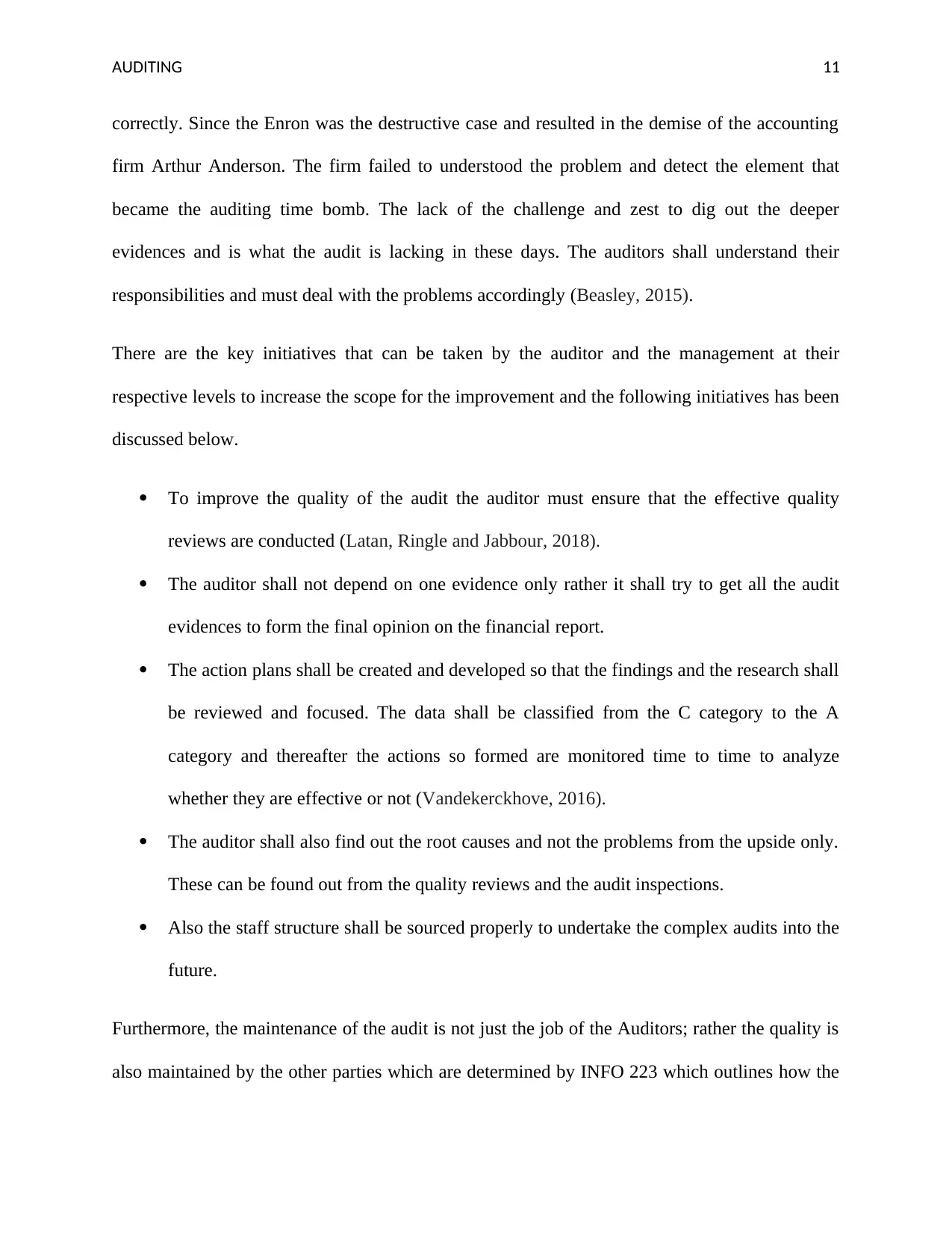
AUDITING 11
correctly. Since the Enron was the destructive case and resulted in the demise of the accounting
firm Arthur Anderson. The firm failed to understood the problem and detect the element that
became the auditing time bomb. The lack of the challenge and zest to dig out the deeper
evidences and is what the audit is lacking in these days. The auditors shall understand their
responsibilities and must deal with the problems accordingly (Beasley, 2015).
There are the key initiatives that can be taken by the auditor and the management at their
respective levels to increase the scope for the improvement and the following initiatives has been
discussed below.
To improve the quality of the audit the auditor must ensure that the effective quality
reviews are conducted (Latan, Ringle and Jabbour, 2018).
The auditor shall not depend on one evidence only rather it shall try to get all the audit
evidences to form the final opinion on the financial report.
The action plans shall be created and developed so that the findings and the research shall
be reviewed and focused. The data shall be classified from the C category to the A
category and thereafter the actions so formed are monitored time to time to analyze
whether they are effective or not (Vandekerckhove, 2016).
The auditor shall also find out the root causes and not the problems from the upside only.
These can be found out from the quality reviews and the audit inspections.
Also the staff structure shall be sourced properly to undertake the complex audits into the
future.
Furthermore, the maintenance of the audit is not just the job of the Auditors; rather the quality is
also maintained by the other parties which are determined by INFO 223 which outlines how the
correctly. Since the Enron was the destructive case and resulted in the demise of the accounting
firm Arthur Anderson. The firm failed to understood the problem and detect the element that
became the auditing time bomb. The lack of the challenge and zest to dig out the deeper
evidences and is what the audit is lacking in these days. The auditors shall understand their
responsibilities and must deal with the problems accordingly (Beasley, 2015).
There are the key initiatives that can be taken by the auditor and the management at their
respective levels to increase the scope for the improvement and the following initiatives has been
discussed below.
To improve the quality of the audit the auditor must ensure that the effective quality
reviews are conducted (Latan, Ringle and Jabbour, 2018).
The auditor shall not depend on one evidence only rather it shall try to get all the audit
evidences to form the final opinion on the financial report.
The action plans shall be created and developed so that the findings and the research shall
be reviewed and focused. The data shall be classified from the C category to the A
category and thereafter the actions so formed are monitored time to time to analyze
whether they are effective or not (Vandekerckhove, 2016).
The auditor shall also find out the root causes and not the problems from the upside only.
These can be found out from the quality reviews and the audit inspections.
Also the staff structure shall be sourced properly to undertake the complex audits into the
future.
Furthermore, the maintenance of the audit is not just the job of the Auditors; rather the quality is
also maintained by the other parties which are determined by INFO 223 which outlines how the
⊘ This is a preview!⊘
Do you want full access?
Subscribe today to unlock all pages.

Trusted by 1+ million students worldwide
1 out of 16
Related Documents
Your All-in-One AI-Powered Toolkit for Academic Success.
+13062052269
info@desklib.com
Available 24*7 on WhatsApp / Email
![[object Object]](/_next/static/media/star-bottom.7253800d.svg)
Unlock your academic potential
Copyright © 2020–2025 A2Z Services. All Rights Reserved. Developed and managed by ZUCOL.




